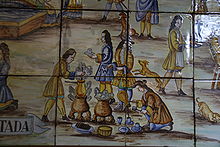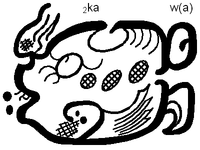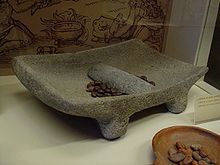- History of chocolate in Spain
-
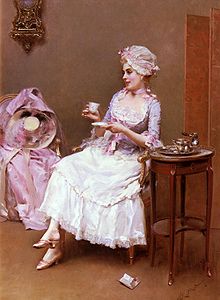 A woman (Aline Masson) drinking a cup of chocolate, in a canvas by Raimundo Madrazo
A woman (Aline Masson) drinking a cup of chocolate, in a canvas by Raimundo Madrazo
The history of chocolate in Spain is part of the culinary history of Spain as understood since the 16th century, when the colonisation of the Americas began and the cocao plant was discovered in regions of Mesoamerica, until the present. After the conquest of Mexico, cocoa as a commodity travelled by boat from the port of Nueva España to the Spanish coast. The first such voyage to Europe occurred at an unknown date in the 1520s. However it was only in the seventeenth century that regular trade began from the port of Veracruz, opening a maritime trade route that would supply the new demand from Spain, and later from other European countries.[1]
The introduction of this ingredient in Spanish culinary traditions was immediate, compared with other ingredients brought from Latin America, and its popularity and acceptance in all sectors of Spanish society reached very high levels by the end of the 16th century. Since its inception, chocolate was considered by Spaniards as a drink and retained that perception until the beginning of the 20th century.
From the early stages, the cocao was sweetened with sugar cane, which the Spanish were the first to popularize in Europe. In pre-Columbus America chocolate was flavored with peppers and was a mixture of both bitter and spicy flavours. This made it an acquired taste and limited its appeal to the Spanish conquistadors, who were soon encouraged to sweeten it with sugar brought from the Iberian Peninsula in addition to heating it.
Over a 100-year period since its first appearance in the ports of Andalusia, chocolate became popular as a drink in Spain, where it was served to the Spanish monarchy. However for a time the formula was unknown in the rest of Europe. Later chocolate spread from Spain to the rest of Europe, with the first countries to adopt it being Italy and France.
The great popularity of the drink in Spanish society from that time until the 19th century is attested to in various reports written by travellers who visited the Iberian peninsula. It was said that "chocolate is to the Spanish what tea is to the English".[2] In this way chocolate was converted into a national symbol.[3] The unusual fondness for this drink meant that coffee remained relatively unpopular in Spain compared to other European countries.[4]
In Spain, chocolate was exclusively considered a refreshing drink, and it was rarely used in other ways—though there are older Spanish dishes that use cocoa. After the Spanish Civil War the custom declined in favour of coffee consumption.[5] In modern Spain, traces of the history of the drink can be seen in the chocolate companies, the chocolate shops and museums.
Contents
Pre-Columbian era
See also: History of chocolateThe Mesoamerican origin of the cacao tree (to which Linnaeus gave the scientific name Theobroma cacao in 1753) is disputed by modern botanical historians[6] since there are different hypotheses about the region from which it comes. Thus, some theories point to the Amazon region;[7] however, it is estimated that the plant also grew in the wild in other parts of Americas, including the plains of the Orinoco Basin. It is very likely that the Olmecs knew the cacao plant, in 1000 BC and transmit its use and cultivation to the Mayans,[8] who were the first to describe cocoa in their hieroglyphics. There is some link between the blood of human sacrifice and the intake of cocoa, and samples found in Mayan tombs strongly imply that the drink was common in the noble classes. The role played in religious ceremonies was explained by Diego de Landa, in his book List of Yucatan things.
As currency
The chronicles of the Spanish conquistadors contain numerous mentions of its use by the Aztecs as a form of currency, which used the Aztec vigesimal system the use of which was widespread. There were specific names, such as the countles consisting of four cocoa beans, the xiquipil consisting of twenty countles and the "burden," which included three xiquipiles. Gonzalo Fernández de Oviedo noted:
"So in the province of Nicaragua, a Rabbit is worth ten kernels and for four kernels they give eight apples or loquat of that excellent fruit they call munonzapot; and a slave is worth more or less 100 of these kernels, depending on the negotiations between the parties involved."
Cocoa was also valued in other contexts such as religious rituals, marital rituals or as medicine (alone or mixed with other plants) as well as being a nutritious food. The widely held belief that it was "a gift from the gods" gave it appeal in pre-Columbian societies as a symbol of economic well-being. Its use as a currency was mostly in the payment of taxes to the powerful.
The age of discovery
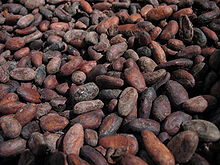 Cocao beans, which the Spanish thought similar in appaearance to almonds.[9]
Cocao beans, which the Spanish thought similar in appaearance to almonds.[9]
The discovery of new foods or preparation methods went through several stages of understanding.[10] Firstly cocoa was understood as a food and later as a pleasant taste. The latter was only possible through adapting the food to flavours previously known. It is in these first encounters of the Spanish Consquistadors with cocoa that we can see that the preparation stage was adapted, it was sweetened and flavoured with other spices such as cinnamon and served warm. After that they had a better understanding of the value of chocolate.[11] Those three simple changes distinguished the chocolate consumed by the Spanish colonisers from the chocolate consumed by the natives. The same pattern occurs in other foods enjoyed at the time by the natives and Spanish.[12] although none of those had an acceptance and a global demand in proportion similar to that of chocolate.
Columbus' first encounter
Main article: Voyages of Christopher ColumbusThe navigator Christopher Columbus, with the economic backing of the Catholic Monarchs, first reached the shores of the New World on 12 October 1492, initially believing that he had reached India. This voyage was carried out to expand markets by establishing new trade routes and therefore rival the Portuguese Empire, which was already well established in Asia. Following the success of that first voyage to the New World, others were organised with the intention of exploring and creating new trade routes.[13] On his fourth voyage, Columbus, in 1502, met an unexpected storm and was forced to temporarily land on 15 August on the Bay Islands. In their first explorations of the area, Columbus' group came upon a boat of Mayan origin travelling from the Yucatán Peninsula. The Spaniards were surprised by the large size of the vessel. Colombus detained the vessel and examined the cargo, which contained cocoa beans that he called almonds in his diary. However, he did not attach importance to these, and after this original inspection he let the boat proceed with its cargo.[14]
In the later period from 1517 to 1519, the Spanish conquistadors Bernal Díaz del Castillo (who referred to the use of cocoa by Aztecs in his book Historia verdadera de la conquista de la Nueva España) and Hernán Cortés both tried the drink and found it to have both bitter and spicy tastes due to the use of achiote. On occasions cornmeal and hallucinogenic mushrooms were also added to the drink.[15] Thereafter the Spaniards knew that cocoa beans were considered legal tender by the locals. Fray Toribio de Benavente (nicknamed Motolinía) mentioned the existence of cocoa in his works such as Memorias or Libro de Cosas de la Nueva España o de los naturales de ella.
Encounters in New Spain
After the conquest of Mexico, the Aztec emperor, Montezuma, offered Hernán Cortés and his companions fifty jars of foaming chocolate. According to the account of Francisco Cervantes de Salazar, the great emperor had a stockpile of several thousand 'charges' (tens of thousands of cocoa "kernels").[16]
The Italian Girolamo Benzoni in his book La Historia del Mondo Nuovo (1565) that "...chocolate seemed more like a drink for pigs than a drink to be consumed by humans" noting that he had never tasted it despite residing there for over a year.[17] Despite these caveats, Gonzalo Fernández de Oviedo characterised it as an interesting ingredient, while showing some reluctance to describe how some Indians, after drinking, had stained his lips as if they had ingested human blood. The perceptions of the Spaniards were changing, in part, due to their increasing reliance on native ingredients. The tortillas made with cornmeal or (tamales), heated without the use of fat did not appear to satisfy the tastes of the conquerors used to pork and culinary techniques based on frying in fat, or sauteed with liberal use of olive oil or bacon.[13] Foods popular in Spain at the time such as cheese were unknown to the inhabitants of the New World.
As the Spanish settlers began to run out the stocks they brought with them, they had to find substitute foods. They therefore began to plant vegetables, such as chickpeas, cereals such as wheat and fruits like oranges or pears. Additionally they introduced the cultivation of olives, grapes and sugar cane. The latter ingredient became important, as from the end of the sixteenth century onwards it began to be added to the cocoa paste leading to greater acceptance of cocoa among the Spanish settlers.
During this settling in period, around the 1520s, the Spaniards had to get used to new foods and flavours while they attempted to adapt old world cultivation methods to the new climate. Equally however the new ingredients brought by the Spanish settlers such as wheat and chickpeas struggled to find acceptance among the native populations who preferred their own homegrown dishes.[18]
Those Spaniards from humble economic backgrounds often married richer Aztecs aften as concubines. They thus tended to eat food influenced by Aztec gastronomy.[13] This hastened the spread of cocoa among both cultures. Bernal Díaz del Castillo mentioned that in a banquet held at the Plaza Grande in Mexico (built on the ruins of the Aztec capital) to celebrate peace between Carlos I of Spain and Francis I of France chocolate was served in golden tablets. The wide acceptance of cocoa by the Spanish conquistadors, especially the women, was also described by the Jesuit José de Acosta in his book Historia natural y moral de las Indias (published in 1590).[19]
As a result, after the initial aversion to cocoa had disappeared, supplies were sent to Spain. The second major transformation of chocolate at the hands of the Spanish was in the serving method: the cocoa was heated until it became liquid. This was in contrast to the natives of the New World, who generally drank it cold or at room temperature.[20] The third change was the addition of spices from the Old World like cinnamon, ground black pepper or aniseed.
Naming the new product
The Aztec language, Nahuatl, was difficult for the Spanish troops stationed in Mexico to pronounce. The common ending tl sounded like te. Hernan Cortes' difficulties with the language was evident in the letters he sent, where he writes "Temistitan" instead of Tenochtitlan and the tribal god Huitzilopochtli as "Huichilobos." Coexistence between the two cultures led to the Spanish language borrowing certain Mesoamerican phrases or words such as coyote or maiz.
Many dictionaries suggest that the word chocolate comes from the Nahuatl chocolatl, based on an evolution from -tl to -te, however, there are problems with this hypothesis. Firstly Coe argued that the word chocolatl does not appear in the Aztec cultural writings of the time,[13] similarly the word is not found in the work of Alonso de Molina, a lexicographer of the time, who wrote a book about the grammar of the Aztec language in 1555. It is also absent from Bernardino de Sahagún's encyclopedia and from the Huehuetlatolli ("The words of the ancients") a guide to moral conduct.[21] In all these works the word cacahuatl (cocoa water) is used. In his periodic letters, Hernán Cortés refers to 'cocoa'. At an indeterminate time in the sixteenth century, the Spanish of New Spain began to use the word chocolatl.
The Royal Family's physician Francisco Hernández de Córdoba already knew this name in the 1570s, describing chocolatl as a drink consisting of cocoa beans and pochotl, a type of tree seed, both ground to powder.[22] José de Acosta and his contemporaries also used the name chocolatl in Nueva España and the Yucatán making the word a neologism. However others have suggested that the word chocolatl came from xocoatl, where xoco means bitter and atl means water.[23] Another possible explanation comes from the colonial habit of making hot cocoa,[9] with many Mayan dictionaries of the time explaining that "the drink called chocolate" comes from chacau haa (literally 'hot water') which is phonetically close to chocolatl.[24][9]
First deliveries to Spain
In 1520 the caravels began delivering Spanish cacao to Spain and the pirates with a letter of marque from England, perhaps due to ignorance of the new ingredient, burned and discarded the contents of the Spanish ships which they seized.[6] No one knows for certain when cocoa first arrived in Spain, however it was considered a valuable material in the mid sixteenth century. The value which the product had can be seen in the strength of the Spanish galleons which carried the first cacao seeds to Spanish ports to prevent their theft.[25]
There is no evidence that Hernan Cortes himself brought any cacao back to Spain on his return trip, as when he met Carlos I, King of Spain and Holy Roman Emperor in 1528, cacao was not listed among the gifts brought back from the New World. The first deliveries to Spain were made by small galleys, which took advantage of the "Chocolate wind", as the favourable North wind in the Gulf of Mexico was known.
Sources
- This article draws heavily on the corresponding article in the Spanish-language Wikipedia, which was accessed in the version of 12 December 2010.
References
- ^ William H. Prescott (1860), History of the Conquest of Mexico, Boughton Press.
- ^ Graciela Ascarrunz De Gilman; Marian Zwerling Sugano (1984), Horizontes culturales y literarios, p. 63.
- ^ Ángel Muro (1890), El Practicón, Madrid
- ^ Carrie Evangeline Farnham (1921), American travellers in Spain: The Spanish inns, 1776-1867, Columbia University Press.
- ^ Rosario García Cruz (2000),Spanish companies in international markets, ESIC Editorial , p. 186.
- ^ a b Kenneth F. Kiple (2000), «Cacao», The Cambridge World History of food, Cambridge University Press, Volume I, section III.e.
- ^ Louis Grivetti, Howard-Yana Shapiro (2009),Chocolate: History, Culture, and Heritage , Willey. ISBN 0-470-12165-3
- ^ Bogin, B. (1997),The evolution of human nutrition. The Anthropology of Medicine: From Culture to Method,Romanucci-Ross, L., Moerman, D. E. & Tancredi, L. R eds., Bergin and Garvey, Westport, CT, pp. 98-142.
- ^ a b c René F. Millon (1955), When Money Grew on Trees. A Study of Cacao in Ancient Mesoamerica, Doctoral dissertation, Department of Anthropology, Columbia University
- ^ Claude Lévi-Strauss (1964), Le Cru et le cuit, París.
- ^ Rafael Montal Montesa (1999), El chocolate «Las semillas de oro», Government of Aragón
- ^ John Germov, Lauren Williams (1999), A sociology of Food and Nutrition, Oxford University Press.
- ^ a b c d Sophie D. Coe, Michael D. Coe (1996), The true History of Chocolate, Thames & Hudson.
- ^ Alfred M. Tozzer (1941), «Landa's Relación de las Cosas de Yucatán», Papers of the Peabody Museum of Archaeology and Ethnology, 18, Harvard University, Cambridge Mass.
- ^ Xavier Castro (2001), «Chocolate y Ayuno», in Ayunos y Yantares, Madrid, chapter 3.
- ^ Francisco Cervantes de Salazar (1936), Crónicas de Nueva España,México, 2 Vols., Museo Nacional de Arqueología y Etnografía, Vol 2:107
- ^ Girolamo Benzoni (1565), La Historia del Mondo Nuovo, Venice.
- ^ Benjamín Hernández Blázquez (2007), El viaje de los garbanzos, Madrid. ISBN 978-84-7392-672-0
- ^ José de Acosta (1590), Historia natural y moral, Madrid.
- ^ Stephen T. Beckett (2008), The Science of Chocolate, RSC Publishing, 2nd ed., p.6.
- ^ Lyle Campbell, Terrence Kaufman (1976), «A linguistic look at the Olmec», American Antiquity, vol. 41, nº 1, pp. 80-86.
- ^ Joseph del Olmo (1680), Relación histórica del Auto General de Fe que se celebró en Madrid este año de 1680, Madrid
- ^ Karen Dakin and Søren Wichmann (2000), «Cacao and Chocolat», Ancient Mesoamerica, 11:1:55-75, doi:10.1017/S0956536100111058
- ^ Santamaría (1959), Diccionario de mejicanismos
- ^ María del Carmen Simón Palmer (1997), La Cocina del Palacio, Madrid, Castalia, p. 61.
Chocolate Background Outline of chocolate · History of chocolate · Health effects of chocolate · History of chocolate in Spain
Origins Varieties Chemicals See also Categories:- Chocolate
- Historical foods
- Spanish cuisine
Wikimedia Foundation. 2010.

